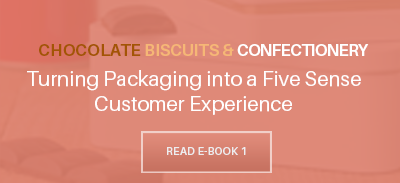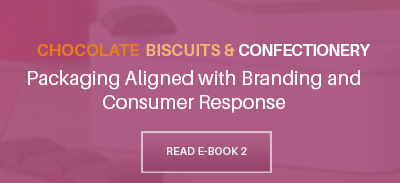People associate tastes, aromas and flavours with packaging shape, name and sound, according to a study from the University of Oxford. Understanding of this mix of sensory perceptions can help product packaging designers improve communication with consumers.
How Taste Relates to Shapes and Sounds
The sweetness and sourness of a food product is commonly associated with other senses. While sweet tastes associate with round images and low pitches, sour tastes associate more with angular shapes and high pitches. These concepts can be conveyed in packaging design to capitalize on these associations.
It's possible to communicate with consumers beyond words by giving them sensory cues that relate to associations with other senses. The sound of the product might be the result of squeezing or shaking it. Consumers can get a feel for how much product is in the package by listening the type of sound it makes.
Participants heard high and low pitches and were asked how these sounds influenced their taste expectations. The study did not take into account other tastes such as bitterness besides sour and sweet. Furthermore, the study did not attempt to test multiple shapes beyond rounded and angular, so deeper research would be necessary to learn the various responses to different shapes.
 Study Results
Study Results
The study, headed by Carlos Velasco, tested people's associations with shapes and sounds using a variety of combinations, such as angular and rounded shapes of typefaces mixed with high and low pitched sounds, as well as sweet and sour tastes. Results revealed that individuals responded to the rounded names more quickly than names with angular typeface. Participants responded more rapidly to rounded typefaces when associated with high-pitched sound. Angular typefaces attracted faster responses when combined with low-pitched sound.
Respondents categorised tastes as sour more rapidly with angular rather than rounded typefaces, whereas rounded typefaces were more quickly linked to sweetness. Angular shapes with angular names got quicker response than rounded shapes with angular names whereas rounded shapes mixed with rounded names got quicker attention than angular shapes paired with rounded names. Participants categorised angular shapes as sour faster than rounded shapes, while rounded shapes were more quickly associated with sweet taste.
 Four-way interactions between the factors of shape, typeface, name and sound were analyzed by the researchers, who found that sour ratings corresponded with high-pitched sounds while sweet ratings corresponded with low-pitched sounds. Sour ratings were also linked more to angular typefaces, whereas sweet ratings were linked more with rounded typefaces. Angular names and shapes were perceived more as sour, while rounded names and shapes were perceived more as sweet.
Four-way interactions between the factors of shape, typeface, name and sound were analyzed by the researchers, who found that sour ratings corresponded with high-pitched sounds while sweet ratings corresponded with low-pitched sounds. Sour ratings were also linked more to angular typefaces, whereas sweet ratings were linked more with rounded typefaces. Angular names and shapes were perceived more as sour, while rounded names and shapes were perceived more as sweet.
One of the key conclusions that one can draw from the study is the rounded variables were associated with sweetness, whereas angular variables were associated with a sour taste. The study also showed that low pitches were categorised more as sweet, while high pitches were categorised more as sour. The results were consistent with previous studies by researchers such as Liang, Roy, Cheng and Zhang. A large body of similar research has developed since the nineties that confirms these packaging shape and sound associations.
Improving Packaging Shape and Sound
Designers can maximize the knowledge that associates the shape and sound of packaging with taste by starting with the desired perception. Food that's meant to taste sweet, for example, should come in a round package, perhaps with rounded typeface. When shaking the package it should produce a low pitch in order for all the associations to align predictably.
The future of packaging shape for food products may be based on further research that associates various tastes with specific shapes. At the moment there are wide open opportunities to take this research to a more comprehensive level. The main takeaway from these studies for designers to absorb is that shapes give off sensory cues that trigger images and expectations in people's minds.
References and Further Reading
-
Author links open overhfhgfhgfhf
Predictive packaging design: Tasting shapes, typefaces, names, and sounds (2013), by CarlosVelasco, Alejandro Salgado-Montejo, Fernando Marmolejo-Ramos, CharlesSpence
- Tough package, strong taste: The influence of packaging design on taste impressions and product evaluations (2011) Liza Becker , Thomas J.L. van Rompay , *, Hendrik N.J. Schifferstein , Mirjam Galetzk in: Journal of Food Quality and Preference, Volume 22, Issue 1, January 2011, Pages 17-23
- Read more on Luxury Packaging by Alex Cosper
- From Disgust to Desire: How Products Elicit Our Emotions (2004), by Pieter M. A. Desmet, in Design and Emotions, edited by Dena McDonagh et al., page 8.
- Definition: Luxury Foodstuffs (retrieved 17.10.2017), Wikidata
- Luxury branding: the industry, trends and future conceptualisations (2015), by Yuri Seo and Margo Buchanan-Oliver
- Food packaging: The medium is the message (2010), by Corinna Hawkes
- More articles on Chocolates , Biscuits and Confectionery packaging, by Alex Cosper and Dawn M. Turner
- Multisensory design: Reaching out to touch the consumer (2011) by Charles Spence and Alberto Gallace
- Assessing the influence of the color of the plate on 2 the perception of a complex food in a restaurant setting (2013), by Betina Piqueras-Fiszman, Agnes Giboreau and Charles Spence
- Does the weight of the dish influence our perception of food? (2011), by Betina Piqueras-Fiszman, Vanessa Harrar, Jorge Alcaide and Charles Spence
- The weight of the container influences expected satiety, perceived density and subsequent expected fullness (2011), by
Betina Piqueras-Fiszman and Charles Spence






